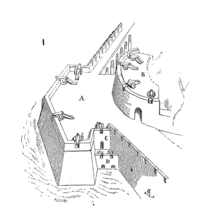
A cavalier is a fortification which is built within a larger fortification, and which is higher than the rest of the work. It usually consists of a raised platform within a fort or bastion, so as to be able to fire over the main parapet without interfering with the fire of the latter. Through the use of cavaliers, a greater volume of fire can be obtained, but its greater height also makes it an easier target for a besieger's guns.
There are two types of cavaliers:
- Common cavalier – a raised gun platform without any additional defensive features
- Defensible cavalier – a raised gun platform surrounded by a ditch. If the ditch cuts across the bastion's terreplein and is supported by cuts, the cavalier can also be considered as a retrenchment.

References
- Spiteri, Stephen C. (2010). "Illustrated Glossary of Terms used in Military Architecture". ARX Supplement. MilitaryArchitecture.com: 5. Archived from the original on 25 October 2010.
- Chisholm, Hugh, ed. (1911). "Cavalier" . Encyclopædia Britannica. Vol. 5 (11th ed.). Cambridge University Press. pp. 562–563.
- Pasley, Charles William (1822). A Course of Elementary Fortification - Volume II (2 ed.). London: John Murray. pp. 337–342.
This military base or fortification article is a stub. You can help Misplaced Pages by expanding it. |